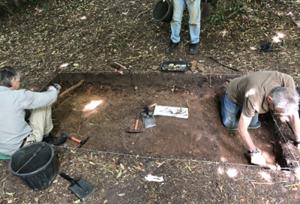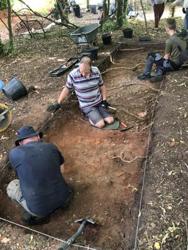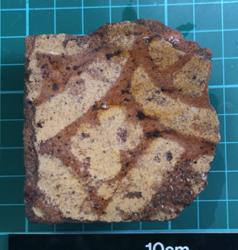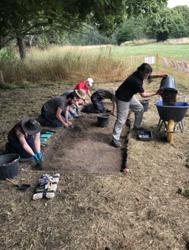10 Jul 2023
2023 Summer Dig - Day 2


It was a decent day's digging today in Forty Hall, on day 2 of our hunt for the inner gatehouse of Elsyng Palace. Although we made good progress and shifted quite a bit of rubble and gravel, the archaeology is not yet entirely clear in either of the trenches we opened yesterday.
We opened Trench 1 yesterday to further examine a very broad and deep cut feature that we dug last year, and may be the remains of the gatehouse moat.
The trench is located in a position that we hope will reveal the western 'inner' side of the cut, but we have not yet removed enough of the post-palace demolition rubble to tell if we've found it yet, although late in the day it did begin to seem as if there was marginally less rubble in the west end of the trench compared to the east. Hopefully tomorrow things should resolve more clearly once the context is fully excavated.

Meanwhile, excavation continued in Trench 2, which is located on top of the adjacent clearly man-made mound in the woods. We're currently working on a substantial demolition context of densely packed coarse rubble, pebbles, chalk, mortar and redeposited brickearth which, at the western end of the trench at least, looks as if it might continue to quite a deptth.
Although there are currently no signs of in situ structure, it cannot be ruled out yet and much more work remains to be done here before we will begin to form a clear picture.
In recent years most of the surviving walls and other structural features of the palace that we've discovered have been buried initially at least under only a few centimetres of soil, but we know from the digs done in the 1960s that this is not always the case at Elsyng - in some instances walls were found metres below the turf, extending for dozens of courses, so we are a long way yet from ruling this out in Trench 2.

Although trench one has not answered its main question yet it did yield the best find of the day - a well preserved fragment of a medieval floor tile from Penn in Buckinghamshire.
Last year we found a fragment of a similar tile, decorated with what turned out to be the figure of a deer, and we are slowly accumulating a collection of such tile fragments. Penn floor tiles are closely dateable, and were popular adornments for higher status buildings in the 14th century. This one has part of a geometric/floral pattern and would have tesselated with several others to produce a larger pattern across the floor.
Evidence of building at Elsyng prior to the Tudor period is very sparse and so any medieval material such as this is always a welcome find, although we would very much like one day to find the floor that they belonged to!

We opened a third trench this afternoon to follow up another unresolved question from last year's dig - we excavated last year close to the end of a known range of buildings in the palace's outer courtyard, to find out its relationship to the 'moat' cut, but ultimately ran out of time to address the question properly.
We have therefore opened a larger trench in the same area to hopefully find out where the exact end of the building range is, and how it connects to the moat cut. We've only so far removed topsoil in trench three, so hopefully should start to get a better picture tomorrow.